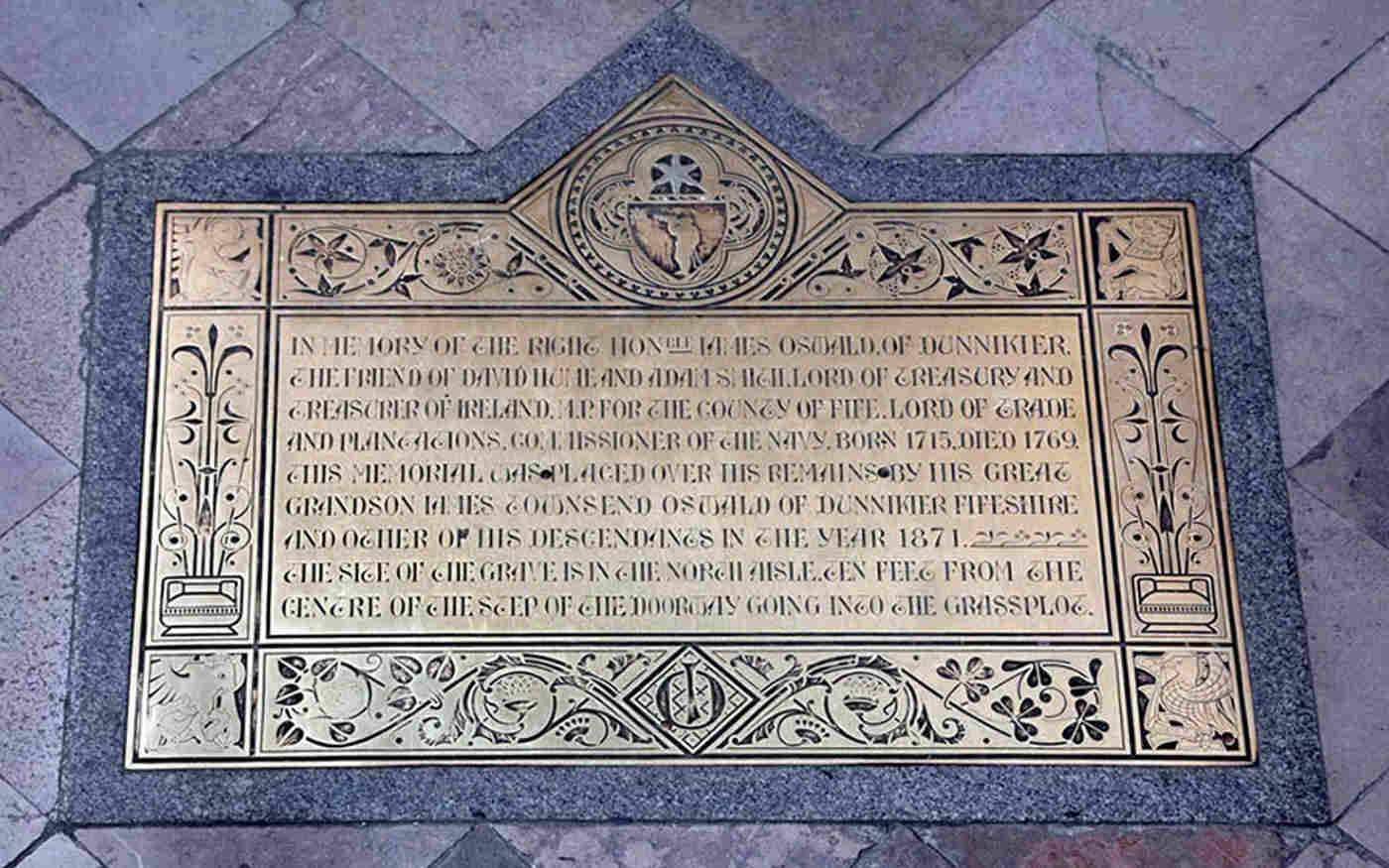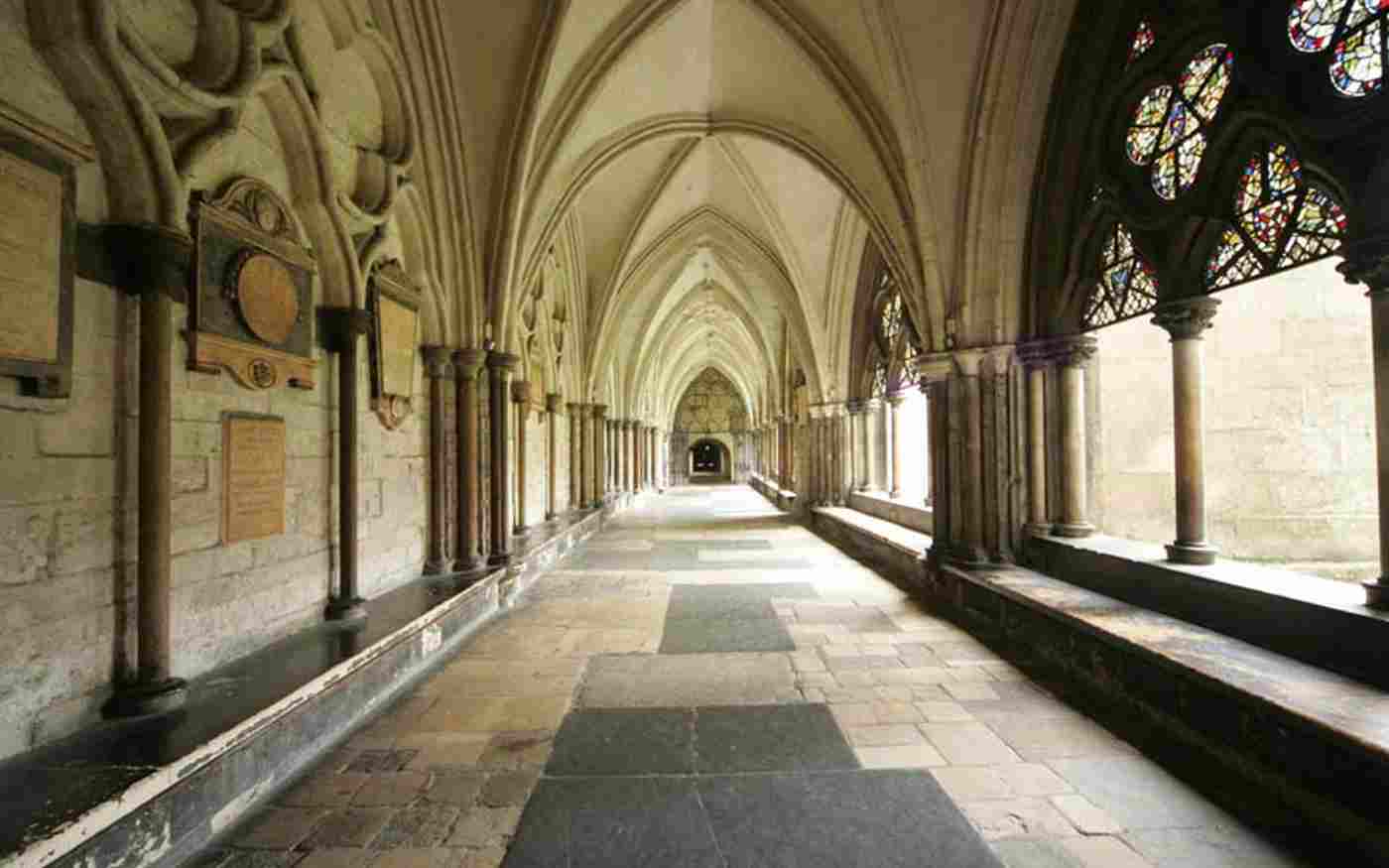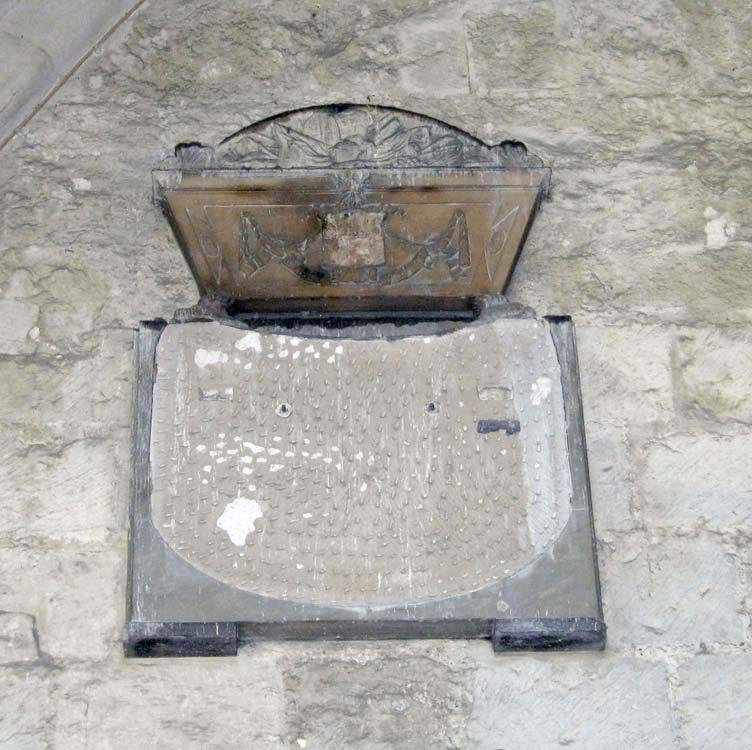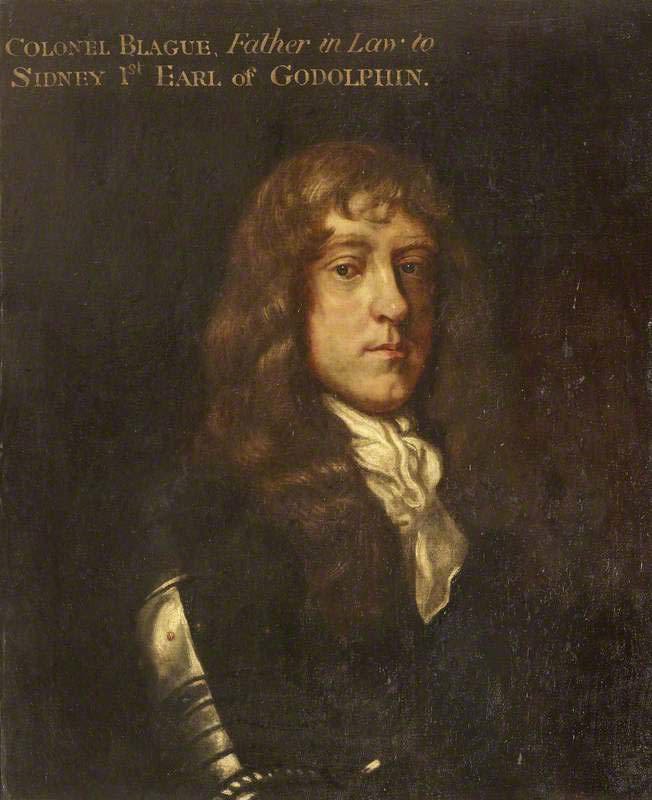Villiers Family
Sir George Villiers and his wife Mary Countess of Buckingham have a white marble monument with effigies in the chapel of St Nicholas in Westminster Abbey. Mary died on 19th April 1632 and was buried a few days later in the chapel. But although Sir George has an effigy he was actually buried on 5th January 1606 at St Denys, Goadby in Leicestershire, near his residence.
On the altar chest he is represented partly in plate armour with a plumed helmet, wearing trunk breeches and a sash on which are depicted shells. His feet rest on a lion. His wife has her head on embroidered cushions with cherub head tassels and wears an ermine lined robe, coronet and jewelled necklace with a pendant cross. She has a lion at her feet also. At each end of the monument chest are heraldic achievements with intials SGV and CMB at the corners. It was made in 1631 at the request of the Countess by sculptor Nicholas Stone who was paid 560 pounds for it. The carvers of the arms were Anthony Goor and Harry Akers. The Latin inscriptions can be translated:
To the good memory of George Villiers Kt. [Knight]. His most devoted wife, Mary Countess of Buckingham, had this statue placed next to her own, out of piety, to a well deserving husband.
To God the best and greatest. The bones of Mary Beaumont, Countess of Buckingham, descended from five of the most powerful kings of Europe, by five direct descents. She lived 62 years, 11 months and 19 days. She caused this monument to be made for her husband.
Sir George, a sheep farmer, was the son of William Villiers and his wife Colett (Clarke). Serving as a sheriff for his native county of Leicestershire he was knighted in 1593 and later served as a Member of Parliament. By his first wife Audrey (Saunders) he had four daughters and two sons - Sir Edward who died in 1626 and Sir William. He married secondly his cousin Mary, daughter of Anthony Beaumont, and had four children - John, Viscount Purbeck, George 1st Duke of Buckingham, Christopher 1st Earl of Anglesey and Susan who married William Feilding, earl of Denbigh. Mary was created Countess of Buckingham in her own right in 1618 and married secondly Sir William Raynor and thirdly Sir Thomas Compton.
George and Mary Villers: life and monument
George Villiers, 1st Duke of Buckingham
Their son George 1st Duke of Buckingham, born 1592, was a favourite of James I and Charles I and has a very large monument by Hubert Le Sueur in one of the apsidal chapels in Henry VII's chapel in the Abbey. He had a rapid rise to power but the effects of his rash counsels soon made him unpopular with the people if not the king. On the eve of leading an expedition for the relief of La Rochelle in France he was assassinated on 23rd August 1628 at Portsmouth by a discontented soldier named John Felton. His mother had such a strong presentiment of his death that she was quite calm on hearing of it and Sir George's ghost was said to have appeared to an old servant just before the murder telling him to go and warn the Duke that he should do something to ingratiate himself with the people or he wouldn't live long. The corpse was escorted back to London and lay in state in Wallingford House while funeral preparations were made.
Charles I ordered the Duke's burial in the chapel which had previously been reserved for those only of royal descent, but with little ceremony for fear of a public uproar. He was buried at night on 18 September.
His monument
His duchess Katherine (Manners) erected the large monument of black and white marble and bronze in 1634. Her effigy is shown beside him but she was actually buried at Waterford in Ireland (died 3rd November 1649). She married secondly Randal MacDonnell, 1st Marquess of Antrim. Another monument was erected in Portsmouth parish church (later the cathedral) by Buckingham's sister Susan, Countess of Denbigh.
The gilded bronze effigy of the Duke shows him in monogrammed plate armour and she is shown in an embroidered dress, ruff, and mantle, both wearing coronets. At their feet is a figure of Fame although it has lost its trumpet. At each corner is a black marble obelisk supported on four skulls with bronze mourning figures of Pallas, Benevolence, Neptune and Mars.
Small statues, by sculptor Isaac Besnier, represent four of their children including Lord Francis Villiers (1629-1648), a posthumous child 'of rare beauty' who was killed fighting the Parliamentary forces and is buried in the Buckingham vault. The other children buried in the Abbey are Charles (1625-1627), George 2nd Duke of Buckingham, and Mary Duchess of Richmond (see below). The Latin inscriptions can be translated:
In perpetual memory of the most high and mighty prince George Villiers, Duke, Marquess and Earl of Buckingham, Earl of Coventry, Viscount Villiers, Baron Whaddon, Lord High Admiral of England, Ireland and Wales, Master of the Horse, Warden of the Cinque Ports, Constable of Dover Castle, Chief Justice in Eyre of the Parks and Forests south of the river Trent, Constable of Windsor Castle, Member of the Privy Council, Knight of the Most Noble Order of the Garter, President of the Council and Chancellor of the university of Cambridge. So memorable a hero was he; highly endowed in both body and mind; the intimate in turn of two most powerful sovereigns, he was famous in peace and war; most famous in the arts; he was a magnificent patron of letters and literary men; of inexhaustible generosity to any worthwhile project, he was unrivalled for his singular humanity and the agreeable nature of his manners; his life was terminated by the most frightful and terrifying murder; to common envy (which is always the partner of virtue and honour) he fell an innocent and undeserved victim.
Catherine, most glorious demi-goddess, daughter and sole heiress of the Earl of Rutland, was made by him [ie.Buckingham] a most joyful mother of children of the greatest promise and of either sex: Lady Mary, Lord Charles (who died in earliest childhood), Lord George, and Lord Francis his youngest and posthumous child. She honoured the most sweet memory of her dearest husband with all possible piety and respect, and saw to it that these titles should be appended, not to satisfy vanity, but to attest the generosity of the greatest Princes: and most sorrowfully enclosed within this monument, which honours him, his sad remains and whatever of him is not yet due to heaven, in the year of the Christian epoch 1634.
Sacred to his dear memory: here he lies, a reproach to the fickle mob: however, Spain marvels at his prudence, France at his courage, Belgium at his diligence, and the whole of Europe at his magnanimity: who was known by the kings of Denmark and Sweden to be irreproachable, by the princes of Germany, Transylvania and Nassau to be upright, by the Venetian Republic to be a lover of monarchy, by the dukes of Lotharingia and Savoy to be a statesman, by the Count Palatine to be loyal, by the Emperor to be a peace maker, by the Turk as a Christian, by the Pope as a Protestant: whom England regarded as Lord High Admiral, Cambridge as Chancellor, and Buckingham as its Duke.
Now stay, O passer by, and hearken to what even Envy herself cannot mock. Here is great Buckingham, a man of disastrous virtue: a loving husband, an affectionate father, an obedient son, a most kindly brother, a generous kinsman, an abiding friend, a beneficent lord, a nobleman who was the servant of all: whom kings loved deeply, whom the nobility held in honour, whom the Church lamented, whom the multitude loathed: whom James and Charles, most perspicacious of monarchs, regarded him as their intimate friend, adorning him with honours and burdening him with commissions: he succumbed to Fate before he found a danger to match his courage.
What then, O stranger? The riddle of the world is dead. He was all things, yet had nothing: named his country's father and its foe: both the delight and the plaint of Parliament: who, while he was waging war against the Papists, was accused of papacy: while promoting the Protestant cause, was slain by a Protestant. Behold the dice of human fortunes. Yet it is not the case that malice shall truly triumph: it was able to kill him, but not to harm him: he who at the moment of death poured forth these prayers: Let me receive thy blood, my Jesus, while the wicked feast upon mine.
When the stone screen of this small chapel was at its original full height (only the lower part now remains) it appears, from an oil painting of about 1740 in the Abbey collection, that a suit of armour, presumably for George, was displayed on the top but this has also now gone.
Their daughter Mary married Charles Herbert, secondly James Stuart, Duke of Lennox and 1st Duke of Richmond, and lastly Colonel Thomas Howard. She was buried in the Richmond vault in Henry VII's chapel on 28th November 1685.
George Villiers, 2nd Duke of Buckingham
George 2nd Duke of Buckingham, courtier and writer, was born 30th January 1628 and brought up with the royal children after his father's death. He fought at the battle of Worcester and escaped to Holland during the Civil War. He bore the orb in the coronation of Charles II in 1661 and was Master of the Horse and ambassador to Paris together with several other posts. On 15th September 1657 he married Mary Fairfax, daughter of Thomas, Lord Fairfax. He died of a chill caught while hunting and died in Yorkshire 16th April 1687 and was buried there. A few months later his body was removed to the Abbey but he has no monument or marker. A large monument had been designed for him but it was never erected. He left no legitimate male heir. Mary was buried in the Buckingham vault on 30th October 1704 aged 67.
Edward Villiers and Family
Sir Edward Villiers was baptised in the Abbey on 15th April 1620, son of Sir Edward Villiers (died 1626) half brother to George 1st Duke of Buckingham, and his wife Barbara, daughter of Sir John St John of Lydiard Tregoz in Wiltshire. Barbara was buried 16th September 1672 in the north ambulatory near St Paul's chapel. His brother Christopher was baptised 8th April 1619 but died young, his sister Barbara was baptised 1st June 1622 (she married Thomas Wenman, then Sir Richard Wentworth and lastly James Howard, Earl of Suffolk and died in 1681) both in the Abbey, and his sister Eleanor was buried here, unmarried, on 16th July 1685. Young Edward married Lady Frances Howard, daughter of Theophilus, Earl of Suffolk and she was buried in the north ambulatory of the Abbey on 27th November 1677. He was married secondly to Martha Love in the Abbey on 25th February 1684. He was a colonel in the army and Knight Marshal of the Royal Household and was buried near his mother on 2nd July 1689.
By his first wife Lady Frances his children were Edward, 1st Earl of Jersey, Katherine and Barbara. The Earl of Jersey succeeded his father as Knight Marshal, and was Master of the Horse to Mary II, and an ambassador abroad. He was also a principal secretary of state and Lord Chamberlain, being created Earl in 1697. He married Barbara, daughter of William Chiffinch, closet keeper to Charles II. His sons were William, 2nd Earl of Jersey, and Henry. He was buried in the north ambulatory on 4th September 1711 aged 56. Katherine Villiers married James Louis du Puissar, a refugee officer, in the Abbey on 20th July 1685. Her second husband was a cousin William Villiers, son of Viscount Grandison. Barbara is the only one of this family to have an extant gravestone. The inscription reads:
Here lyeth the body of BARBARAH VILLIERS VISCOUNTESS FITZHARDING Governess to His late Royall Highness the Duke of Glocester, daughter to the Hon. Sr EDWARD and the Hon. Lady FRANCES VILLIERS and who died September 19th 1708 in her 52nd year.
Francis Villiers
He was the second son of George Villiers, 4th Viscount Grandison and his wife Lady Mary Leigh (daughter of the 1st Earl of Chichester) and was buried in the Abbey on 4th February 1694 although the location is not known. He was Lt. of the Band of Gentlemen Pensioners and was appointed one of the four Tellers of the Exchequer in 1685. He lived at Parsons Green, Fulham and was the "Frank Villiers" or "Villain Frank" of the State Poems. His brother was Charles and his sister Elizabeth.
A Catherine Villiers, daughter of Reverend George Villiers (a descendant of John, Viscount Purbeck) vicar of Chalgrove in Oxfordshire, married John Lewis of Dartford, Kent in the Abbey on 7th November 1747.
Photos of the monuments to Sir George Villiers, and George 1st Duke of Buckingham can be purchased from Westminster Abbey Library.
With thanks to Pamela Womack for help in locating the burial places of Sir George and Katharine.
Further reading
Oxford Dictionary of National Biography for George (1st Duke of Buckingham), George (2nd Duke of Buckingham) and Edward
The accounts of Katherine Duchess of Buckingham are at the Centre for Buckinghamshire Studies.
Edward Pierce's design for a proposed monument to the 2nd Duke is in the British Museum collection.
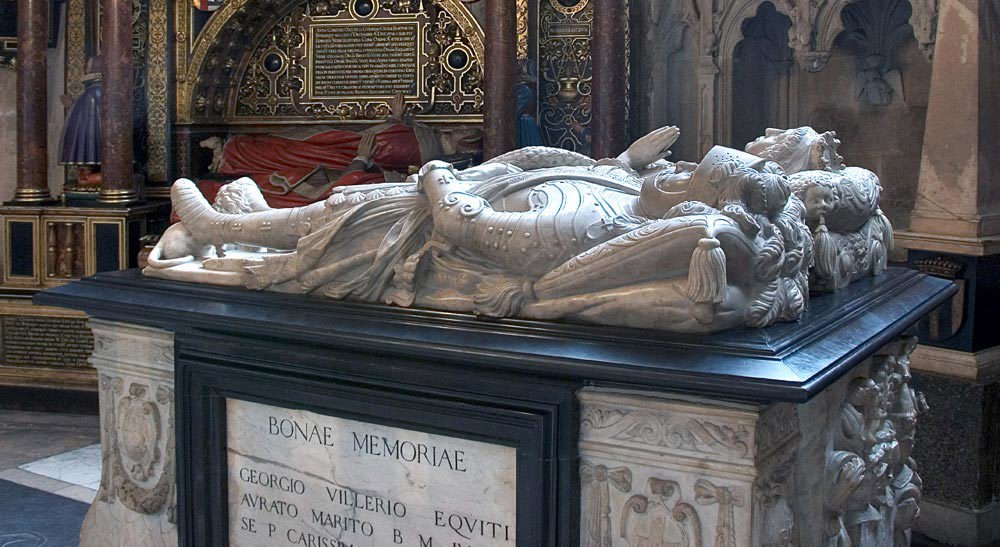
This image can be purchased from Westminster Abbey Library
Image © 2025 Dean and Chapter of Westminster
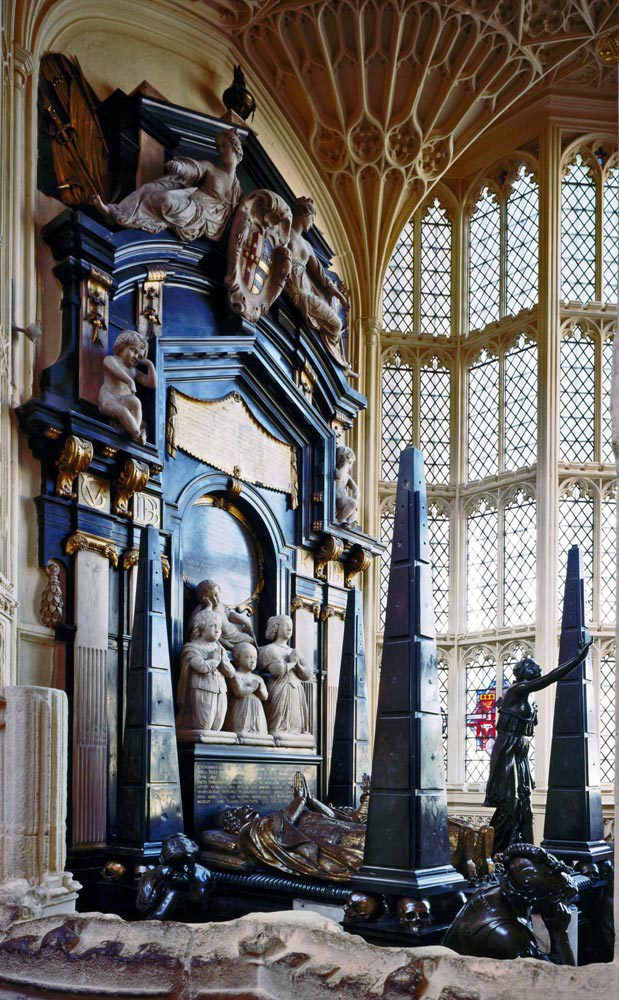
This image can be purchased from Westminster Abbey Library
Image © 2025 Dean and Chapter of Westminster
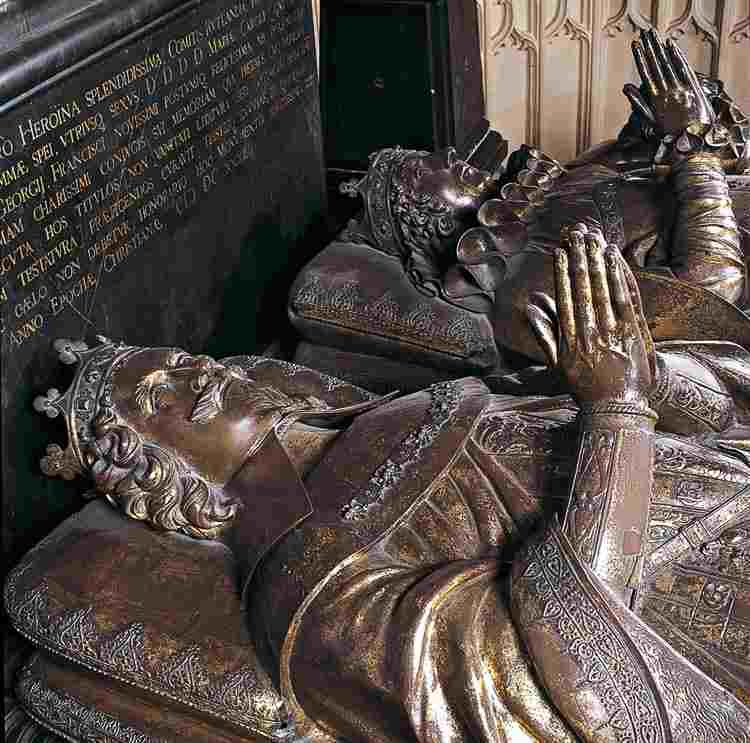
This image can be purchased from Westminster Abbey Library
Image © 2025 Dean and Chapter of Westminster
